| Revision as of 05:39, 1 January 2014 editRockin90 (talk | contribs)451 editsNo edit summary← Previous edit | Revision as of 00:02, 3 January 2014 edit undoShortCappy (talk | contribs)227 edits →Police buses: Removed picture of TMC RTS bus, which retired; corrected the make name of another RTS bus (9827)Next edit → | ||
| Line 399: | Line 399: | ||
| |- | |- | ||
| {{NYPD Vehicle|] body on ] chassis |USA||NYPD Police Bus TB33 4092.jpg}} | {{NYPD Vehicle|] body on ] chassis |USA||NYPD Police Bus TB33 4092.jpg}} | ||
| {{NYPD Vehicle|] ]|USA |
{{NYPD Vehicle|] ]|USA}} | ||
| {{NYPD Vehicle|] V Suburban|CAN|USA}} | {{NYPD Vehicle|] V Suburban|CAN|USA}} | ||
| {{NYPD Vehicle|Modified ] ]|USA||NYPD Command Unit.JPG|Mobile command post}} | {{NYPD Vehicle|Modified ] ]|USA||NYPD Command Unit.JPG|Mobile command post}} | ||
| |- | |- | ||
| !colspan=4| | !colspan=4| | ||
| === ]s === | === ]s === | ||
| |- | |- | ||
Revision as of 00:02, 3 January 2014
"NYPD" and "New York City Cops" redirect here. For the state police, see New York State Police. Not to be confused with New York City Sheriff's Office. Law enforcement agency| City of New York Police Department | |
|---|---|
| [REDACTED] The New York City Police Department patch, depicting the department logo. | |
| The shield of the New York City Police Department (NYPD), with badge number "911".The shield of the New York City Police Department (NYPD), with badge number "911". | |
| Flag of the New York City Police DepartmentFlag of the New York City Police Department | |
| Common name | New York City Police Department |
| Abbreviation | NYPD |
| Motto | Fidelis ad Mortem (Template:Lang-en) |
| Agency overview | |
| Formed | 1845 |
| Employees | 34,500 (Uniformed) |
| Annual budget | $3.6 billion |
| Jurisdictional structure | |
| Operations jurisdiction | New York, U.S. |
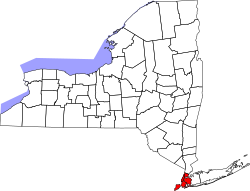 | |
| Map of City of New York Police Department's jurisdiction | |
| Size | 468.9 square miles (1,214 km) |
| Population | 8,175,133 |
| Legal jurisdiction | New York City |
| General nature | |
| Operational structure | |
| Headquarters | 1 Police Plaza |
| Police Commissioner responsible | |
| Agency executive |
|
| Parent agency | New York City |
| Units |
List
|
| Boroughs |
List
|
| Facilities | |
| Commands | 77 Precincts 12 Transit Districts 9 Housing Police Service Areas |
| Police cars | 8,839 |
| Police boats | 11 |
| Helicopters | 8 |
| Horses | 120 |
| Dogs | 31 German Shepherds 3 Bloodhounds |
| Website | |
| www.NYC.gov | |
The New York City Police Department (NYPD or NYCPD), officially the City of New York Police Department, was established in 1845, and is the largest municipal police force in the United States, having primary responsibilities in law enforcement and investigation within the five boroughs of New York City. The NYPD is one of the oldest police departments established in the United States; tracing its roots back to the first Dutch eight man night watch in 1625, when New York City was New Amsterdam.
The NYPD has a broad array of specialized services, including the Emergency Service Unit, K-9, harbor patrol, air support, bomb disposal, counter-terrorism, criminal intelligence, anti-gang, anti-organized crime, narcotics, public transportation and public housing; The New York City Transit Police and New York City Housing Authority Police Department were fully integrated into the NYPD in 1995. According to the department, its mission is to "enforce the laws, preserve the peace, reduce fear, and provide for a safe environment."
In June 2004, there were about 40,000 sworn officers plus several thousand support staff; in June 2005, that number dropped to 35,000. As of December 2011, it had increased to slightly over 36,600 with the graduation of a class of 1,500 from the New York City Police Academy. The NYPD's current authorized uniformed strength is 34,450. There are also approximately 4,500 Auxiliary Police Officers, 5,000 School Safety Agents, 2,300 Traffic Enforcement Agents, and 370 Traffic Enforcement Supervisors currently employed by the department. The Patrolmen's Benevolent Association of the City of New York (NYC PBA), the largest municipal police union in the United States, represents over 50,000 active and retired NYC police officers.
The NYPD Intelligence Division & Counter-Terrorism Bureau, headed by a former CIA operative, has officers stationed in 11 foreign cities such as London, Paris, Madrid, Tel Aviv, Hamburg, and Toronto. In the 1990s the department developed a CompStat system of management which has also entered use in other cities.
Members of the NYPD are frequently referred to by the nickname New York's Finest. The NYPD is headquartered at 1 Police Plaza, located on Park Row in Lower Manhattan across the street from City Hall.
NYPD has extensive crime scene investigation and laboratory resources, as well as units which assist with computer crime investigations. The NYPD runs an anticrime computer network, essentially a large search engine and data warehouse operated by detectives to assist officers in the field with their investigations. A Domain Awareness System, a joint project of Microsoft and NYPD, links thousands of closed-circuit television cameras, license plate readers, and other surveillance devices into an integrated system.
History
Main article: History of the New York City Police DepartmentThe New York City Police Department was established in 1845, replacing an old night watch system.
Rank structure
| This section does not cite any sources. Please help improve this section by adding citations to reliable sources. Unsourced material may be challenged and removed. (February 2010) (Learn how and when to remove this message) |
- This articles discusses ranks of the NYPD proper; whereas the School Safety Division, Traffic Control Division, Auxiliary Police Section and Police Academy have their own rank and grade structures despite being part of the NYPD and commanded by officers of the NYPD proper command structure.
Officers begin service with the rank of Probationary Police Officer, alternatively referred to as P.P.O. or informally within the department, as a Probie. After six months of training at the Police Academy and after successfully completing various Academic, Physical and Tactical tests, officers graduate the Police Academy and are promoted to the rank of Police Officer and receive a corresponding pay grade increase.
There are three career "tracks" in the New York City Police Department. The supervisory track consists of 12 sworn titles, referred to as ranks. Promotion to the ranks of sergeant, lieutenant and captain are made via competitive civil service examinations. Promotion to the ranks of deputy inspector, inspector and chief are made at the discretion of the Police Commissioner, after successfully passing all three civil service exams. Promotion from the rank of Police Officer to Detective is determined by the current police labor contract with approval of the Police Commissioner. The entry level appointment to detective is third grade or specialist. The Police Commissioner may grant discretionary grades of first or second grade. These grades roughly correspond to compensation equivalent to supervisors. Specifically, a second grade detective's pay roughly corresponds to a sergeant and a first grade detective's pay roughly corresponds to a lieutenant. Detectives are police officers that have been given titles and have no official supervisory authority. A Detective First Grade still falls under the command of a Sergeant or above. Similar to detective grades, Sergeants and Lieutenants also can receive pay grade increases within their rank.
The other two tracks are the investigative track and the specialist track.
| Title | Insignia | Uniform | Badge design | Badge Color | Badge Numbered |
|---|---|---|---|---|---|
| Chief of Department | White shirt, black peaked cap |
Medallion with eagle and stars | gold, silver stars | no | |
| Bureau Chief | |||||
| Assistant Chief | |||||
| Deputy Chief | Medallion with eagle and star | ||||
| Inspector | Medallion with eagle | gold | |||
| Deputy Inspector | Laurels and crown with oak leaves | ||||
| Captain | Laurels and crown | ||||
| Lieutenant | Medallion | ||||
| Sergeant | Navy blue shirt, peaked cap |
Shield with eagle | yes | ||
| Detective (grades 3rd–1st) | Medallion | ||||
| Police Officer | Shield | silver | |||
| Probationary Police Officer | |||||
| Recruit Officer | Slate grey, black side cap | ||||
| Cadet | none | ||||
There are two basic types of detective in the NYPD: detective-investigators and detective-specialists.

Detective-Investigators are the type most people associate with the term "detective" and are the ones most frequently portrayed on television and in the movies. Most police officers gain their detective title by working in the Narcotics Division of the Organized Crime Control Bureau and are then moved to the Detective Bureau. Detectives assigned to squads are co-located within each precinct and are responsible for investigating murders, rapes, robberies, burglaries and other crimes within that precinct's boundaries. Other detective-investigators are assigned to specialized units at either the major command or citywide level, investigating terrorist groups, organized crime, narcotics dealing, extortion, bias crimes, political corruption, kidnappings, major frauds or thefts committed against banks or museums, police corruption, contractor fraud and other complex, politically sensitive or high-profile cases. A squad of detective-investigators is also assigned to each of the city's five district attorney's offices. (Arsons are investigated by The Arson and Explosion Squad as well as fire marshals, who are part of the New York City Fire Department.)
Promotion from Police Officer to Detective-Investigator is based on investigative experience. Typically, a Police Officer who is assigned to investigative work for 18 months will be designated "Detective-Investigator" and receive the gold shield and pay increase commensurate with that designation. In the recent past, however, there has been controversy over the budget-conscious department compelling police officers to work past the 18 months without receiving the new title.
Newly appointed detectives start at Detective Third Grade, which has a pay rate roughly between that of Police Officer and Sergeant. As they gain seniority and experience, they can be "promoted" to Detective Second-Grade, which has a pay grade slightly less than sergeants. Detective First-Grade is an elite designation for the department's most senior and experienced investigators and carries a pay grade slightly less than Lieutenants. All these promotions are discretionary on the part of the Commissioner and can be revoked if warranted. And while senior detectives can give directions to junior detectives in their own squads, not even the most senior detective can lawfully issue orders to even a junior patrol officer. All Detective grades still fall under the "chain of command" of the supervisory ranks beginning with Sergeant through Chief of Department. Detectives, like Police Officers, are eligible to take the promotional civil service exams for entry into the supervisory ranks.
While carrying with them increased pay and prestige, none of these Detective grades confer on the holder any supervisory authority. Contrary to some media portrayals, there is no specific rank of "Detective Sergeant" or "Detective Lieutenant". Lieutenants and Sergeants are assigned to oversee Detective squads as Supervisors, and are responsible for all investigations.
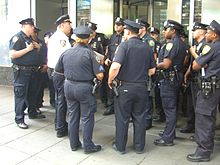
There is a small percentage of Lieutenants and Sergeants who work as Investigative Supervisors (approximately equal to 10% of their respective ranks) and are granted the prestigious pay grade designations of "Sergeant—Supervisor Detective Squad" (SDS), or Lieutenant—Commander Detective Squad (CDS) therefore assuming full Investigative command responsibility as opposed to operational supervision. Their pay grade rises to an approximate midpoint between their normal rank and the next highest rank's pay grade, and similar to a Detective's "grade", is also a discretionary promotion. This pay grade designation is achieved by assignment to Investigative units, i.e. Detective Bureau, Internal Affairs Bureau, Counter-Terrorism Bureau, Intelligence Bureau, and Organized Crime Control Bureau. Lieutenants and Sergeants in non-investigatory assignments can be designated Lieutenant-Special Assignment or Sergeant-Special Assignment, pay equivalent to their investigative counterparts.
"Detective-specialists" are a relatively new designation and one unique to the NYPD. In the 1980s, many detectives resented that some officers were being granted the rank of detective in order to give them increased pay and status, but were not being assigned to investigative duties. Examples included officers assigned as bodyguards and drivers to the mayor, police commissioner and other senior officials.
To remedy this situation, the rank of detective-specialist was created. These officers are typically found in specialized units because they possess a unique or esoteric skill the department needs, e.g., crime-scene techs, sharpshooter, bomb technician, scuba instructor, helicopter instructor, sketch artist, etc. Like detective-investigators, detective-specialists start at third grade and can be promoted to second- or first-grade status.
The Department is administered and governed by the Police Commissioner, who is appointed by the Mayor. Technically, the commissioner serves a five-year term; as a practical matter, the commissioner serves at the Mayor's pleasure. The commissioner in turn appoints numerous deputy commissioners. The commissioner and his subordinate deputies are civilians under an oath of office and are not uniformed members of the force who are sworn officers of the law. However, a police commissioner who comes up from the uniformed ranks retains that status while serving as police commissioner. This has ramifications for their police pensions and the fact that any police commissioner who is considered sworn does not need a pistol permit to carry a firearm, and does retain the statutory powers of a police officer. Some police commissioners (like Ray Kelly) do carry a personal firearm, but they also have a full-time security detail from the Police Commissioner's (Detective) Squad.
A First Deputy Police Commissioner may have a security detail when he/she acts as commissioner or under other circumstances as approved by the police commissioner.
Commissioner titles:
| Title | Insignia |
|---|---|
| Police Commissioner | |
| First Deputy Commissioner | |
| Deputy Commissioner |
These individuals are administrators who supersede the Chief of Department, and they usually specialize in areas of great importance to the Department, such as counter-terrorism, operations, training, public information, legal matters, intelligence, and information technology. Despite their role, as civilian administrators of the Department, they are prohibited from taking operational control of a police situation (with the exception of the Commissioner and the First Deputy Commissioner).
Within the rank structure, there are also designations, known as "grades", that connote differences in duties, experience, and pay. However, supervisory functions are generally reserved for the rank of sergeant and above.
Badges in the New York City Police Department are referred to as "shields" (the traditional term), though not all badge designs are strictly shield-shaped. Every rank has a different badge design (with the exception of Police Officer and Probationary Police Officer), and upon change in rank officers receive a new badge. Lower-ranked police officers are identified by their shield numbers, and tax registry number. Lieutenants and above do not have shield numbers and are identified by tax registry number. All sworn members of the NYPD have their I.D. card photos taken against a red background. Civilian employees of the NYPD have their I.D. card photos taken against a blue background, signifying that they are not commissioned to carry a firearm. All ID cards have an expiration date.
Organization and structure
Main article: Organization of the New York City Police Department
The Department is divided into ten bureaus, six of which are enforcement bureaus. Each enforcement bureau is sub-divided into sections, divisions, and units, and into patrol boroughs, precincts, and detective squads. Each Bureau is commanded by a Bureau Chief (such as the Chief of Patrol, the Chief of Housing, Chief of Internal Affairs). There are also a number of specialized units (such as the Operations Unit and Compstat) that are not part of any of the Bureaus and report to the Chief of the Department.
Personnel
Main article: List of New York City Police Department officers
Line of duty deaths
Since December 25, 1806, the NYPD has lost 781 officers in the line of duty, the most-recent officer being lost on December 12, 2011. This figure includes officers from agencies that were absorbed by or became a part of the modern NYD in addition to the modern department itself. This number also includes officers killed on and off duty by gunfire of other officers on duty. The NYPD lost 23 officers in the September 11, 2001, attacks.
| Type | number |
|---|---|
| 9/11 related illness | 31 |
| Accidental | 10 |
| Aircraft accident | 7 |
| Animal related | 17 |
| Asphyxiation | 2 |
| Assault | 31 |
| Automobile accident | 51 |
| Bicycle accident | 4 |
| Boating accident | 5 |
| Bomb | 2 |
| Drowned | 12 |
| Duty related illness | 10 |
| Electrocuted | 5 |
| Explosion | 8 |
| Exposure | 1 |
| Fall | 12 |
| Fire | 14 |
| Gunfire | 323 |
| Gunfire (accidental) | 24 |
| Heart attack | 44 |
| Motorcycle accident | 36 |
| Stabbed | 24 |
| Struck by streetcar | 7 |
| Struck by train | 5 |
| Struck by vehicle | 37 |
| Structure collapse | 3 |
| Terrorist attack | 23 |
| Vehicle pursuit | 12 |
| Vehicular assault | 20 |
| Total | 863 |
Civilian Complaint Review Board (CCRB)
Main article: Civilian Complaint Review BoardThe Civilian Complaint Review Board is an all-civilian board tasked with investigating complaints about alleged misconduct on the part of the NYPD.
Medals
Main article: Medals of the New York City Police DepartmentThe NYPD presents medals to its members (upon request and a self-initiated write-up) for meritorious service.
Demographics
As of the end of 2010, 53% of the entire 34,526-member police force were white and 47% were minorities. Of 22,199 officers on patrol, 53% (11,717) were black, Latino (any race), or Asian, and 47% (10,482) were non-Hispanic white. Of 5,177 detectives, 57% (2,953) were white and 43% (2,224) were minorities. Of 4,639 sergeants, 61% (2,841) were white and 39% (1,798) were minorities. Of 1,742 lieutenants, 76% (1,323) were white and 24% (419) were minorities. Of 432 captains, 82% (356) were white and 18% (76) were minorities. Of 10 chiefs, 7 were white and 3 were minorities. In 2002, whites accounted for 60% of members in the rank of police officer. Between 2002 and 2010, the number of minorities in top-tier positions in the force increased by about 4.5%.
Affiliations
The NYPD is affiliated with the New York City Police Foundation and the New York City Police Museum. It also runs a Youth Police academy to provide positive interaction with police officers and to educate young people about the challenges and responsibility of police work. The department also provides a citizen Police Academy which educates the public on basic law and policing procedures.
Vehicles
Cruisers | |||
|---|---|---|---|
| Ford Crown Victoria | United States (origin) Canada (manufacture) |

|
|
| Ford Police Interceptor Sedan | United States | 
|
|
| Chevrolet Impala | United States (origin) Canada (manufacture) |
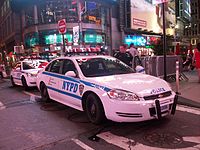
|
|
| Ford Fusion Hybrid | United States (origin) Mexico (manufacture) |

|
|
| Nissan Altima | JAP (origin) United States (manufacture) |

|
|
| Dodge Charger | United States (origin) Canada (manufacture) |

|
|
| Toyota Prius | JAP | 
|
|
| Chevrolet Volt | United States | 
|
|
SUVs | |||
| Chevrolet Tahoe/GMC Yukon | United States | ||
| Ford Explorer Special Service Vehicle | United States | 
|
|
| Ford Escape Hybrid | United States | 
|
|
| Cadillac Escalade | United States | 
|
|
Parking Enforcement Scooters | |||
| Westward Go-4 Interceptor | Canada | 
|
|
| Cushman | United States | 
|
|
Emergency Service Unit vehicles | |||
| Lenco Peacekeeper | United States |
| |
| Lenco BearCat | United States | 
|
|
| Modified Ford F-550 | United States | 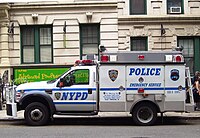
|
|
| Mack | United States | 
|
|
Communications vans | |||
| Chevrolet van | United States | 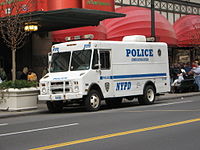
|
|

|
| ||
Police buses | |||
| AmTran body on Navistar International chassis | United States | 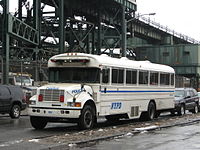
|
|
| Nova Bus RTS | United States | ||
| Orion V Suburban | Canada (origin) United States (manufacture) |
||
| Modified Blue Bird All American | United States | 
|
|
Helicopters | |||
| AgustaWestland AW119 | |||
| Bell Helicopter Bell 412EP | United States | ||
Miscellaneous | |||
| Ford E-Series | United States | 
|
|
| Modified Hummer H1 | United States |
| |
| John Deere Gator | United States | 
|
|
Firearms
On Duty
New NYPD officers are allowed to select one of three 9mm service pistols: the SIG Sauer P226 DAO, Smith & Wesson Model 5946 DAO, and Glock 19. All are modified to a 12-pound (53 N) NY-2 trigger pull. Officers who were issued revolvers prior to the transition to semi-automatic pistols on January 1, 1994, are "grandfathered" and if so can choose to continue to carry a revolver as a duty weapon.
Off Duty
The firearms approved by the NYPD for off duty carry are the Glock 26, Smith & Wesson 3914 DAO, Smith & Wesson 3953TSW, Smith & Wesson Model 640 (.38 revolver), and the SIG Sauer P239 DAO. Along with those weapons, NYPD officers may also carry their department issued firearms while off duty.
Retired
From 1926 until 1986 the standard weapons of the department were the Smith & Wesson Model 10 and the Colt Official Police .38 Special Revolvers with four-inch barrels. Prior to 1994 the standard weapon of the NYPD was the Smith & Wesson Model 64 DAO (Double Action Only) .38 Special Revolver with three or four inch barrels. This type of revolver was called the Model NY-1 by the department.
Prior to the issuing of the 9mm semi-automatic pistol NYPD Detectives and plain clothes officers often carried the Colt Detective Special and/or the Smith & Wesson Model 36 "Chief's Special" .38 Special caliber snub-nosed (2-inch) barrel revolvers for their easiness to conceal while dressed in civilian clothes.
Controversies
Main article: New York City Police Department corruption and misconduct
The NYPD has come under scrutiny for its use of stop-and-frisk.
Salary and retention issues
| The neutrality of this article is disputed. Relevant discussion may be found on the talk page. Please do not remove this message until conditions to do so are met. (October 2011) (Learn how and when to remove this message) |
After years of bitter wrangling that saw starting pay for new officers fall to $25,100 a year, the city and the Patrolmen's Benevolent Association reached agreement on August 21, 2008 on a new four-year contract.
The contract, which runs from August 1, 2006 to July 31, 2010, gives police officers a 17 percent pay raise over its four-year life, and raises starting pay from $35,881 to $41,975, and top pay from $65,382 to approximately $76,000 annually. With longevity pay, holiday pay, night shift differential and other non-guaranteed additions, the total annual compensation for officers receiving top pay will be approximately $90,829. This is the first contract since 1994 that the Patrolmen's Benevolent Association and the City of New York mutually agreed on without involving a mediator.
Many think that the new terms still leave a substantial pay gap between the NYPD and nearby departments. Over the years, thousands of city officers have left for higher paying jobs with other agencies, notably the Nassau County Police Department, the Suffolk County Police Department, Westchester County police departments, the Metropolitan Transportation Authority Police and the Port Authority Police of New York and New Jersey. Discontent over pay issues has become so widespread and so well known that higher-paying departments in lower cost-of-living cities, such as the Rochester, New York Police, the Albuquerque, New Mexico Police, and the Seattle Police Department, are actively recruiting NYPD officers to join their forces.
Large numbers of NYPD officers have also migrated to the New York City Fire Department, where, even though pay is comparable with that of the NYPD, work schedules are more attractive and relations with the public more amicable. Contract changes in 2006, however, now forbid the prior practice of allowing police officers who join the fire department to transfer their seniority for compensation purposes. With all new firefighters now compelled to begin working at the same starting pay, the number of NYPD officers "rolling over" to the FDNY is likely to fall considerably.
Some NYPD officers charge that the department's leadership is seeking to stem the flow of officers to other jurisdictions by administrative means. In January 2006, 35 NYPD officers seeking to move to the Port Authority Police sued the New York department, claiming that it was refusing to make their personnel records available to PAPD background investigators. The plaintiffs won an injunction at the trial level, but the Appellate Division in January 2007 overturned that ruling and ordered the case to trial. The NYPD claims its actions are merely in line with the personnel practices of other employers and that there is no "stealth" effort to prevent officers from moving elsewhere. Nonetheless, no NYPD officers have been included in the last two PAPD police academy.
Despite these obstacles, there are signs that the exodus from the NYPD may be accelerating. In 2007, 990 officers resigned before becoming eligible for retirement, versus 902 who left in 2006, 867 in 2005 and 635 in 2004, which makes for an attrition rate of around two percent. While Police Commissioner Raymond Kelly insists that that figure compares positively with turnover rates in private industry, police union officials argue that the proper comparison should be with prior years on the NYPD. In 1991, for example, only 159 officers left early, for an attrition rate of less than one half of one percent. "Cop Exits Up 11%; Pay Prime Factor," by Reuven Blau, The Chief-Leader, March 7, 2008.</ref>
In popular culture
Further information: List of fictional portrayals of the NYPDSee also
- Law enforcement in New York
- Law enforcement in New York City
- List of law enforcement agencies in New York
References
- http://www.policetestguide.com/resources/new-york-police-department/
- http://www.nyc.gov/html/nypd/html/faq/faq_police.shtml
- "Chief Banks biography at NYPD website". Nyc.gov. 2011-02-16. Retrieved 2013-09-27.
- "Bureau of Justice Statistics - Appendix table 1 - page 34" (PDF). Department of Justice. Retrieved December 5, 2013.
- "History.com". History.com. Retrieved 2013-09-27.
- "NYPD - Frequently Asked Questions". Nyc.gov. Retrieved 2013-09-27.
- "NYPD Intelligence making FBI blue". Voices.washingtonpost.com. 2010-04-26. Retrieved 2013-09-27.
- "Document shows NYPD eyed Shiites based on religion". Associated Press - Ap.org. Retrieved 2013-09-27.
- Hartmann, Margaret (2012-01-27). "NYPD Now Has an Israel Branch, New York Magazine". Nymag.com. Retrieved 2013-09-27.
- "Property Clerk." New York City Police Department". Nyc.gov. 2011-02-16. Retrieved 2013-09-27.
- From database to crime scene
- NYPD launches new all-seeing 'Domestic Awareness System' RT News, 30 July 2012
- NEWMAN, ANDY (12 December 2011). "Officer Shot and Killed in Brooklyn". New York Times. Retrieved 17 March 2012.
- "9/11 by the Numbers". New York Magazine. September 11, 2002.
- "The Officer Down Memorial Page".
- "September 11, 2001". Nypdangels.com. 2001-09-11. Retrieved 2013-09-27.
- El-Ghobashy, Tamer (January 7, 2011). "Minorities Gain in NYPD Ranks". Wall Street Journal. Retrieved May 8, 2012.
- cite web|url = http://www.policemag.com/channel/vehicles/news/2012/07/03/nypd-picks-ford-p-i-as-new-patrol-car.aspx |title = Police Magazine |publisher = Policemag.com |date = |accessdate = 2013-09-27
- cite web|author = The Ford Motor Company |url = https://media.ford.com/content/fordmedia/fna/us/en/news/2012/02/08/ford_s-all-new-police-interceptors-roll-off-the-chicago-assembly.html |title = Ford’s All-New Police Interceptors Roll Off the Chicago Assembly Line, Purpose-Built to Protect and Serve | Ford Media Center |publisher = Media.ford.com |date = 2012-02-08 |accessdate = 2013-09-27
- "Training Bureau | Firearms & Tactics Section". nyc.gov. Retrieved 2009-12-02.
- Massad Ayoob (December 1999). "Trendy Guns Don't Sell Like The Classics". Shooting Industry.
- Leghorn, Nick. (2012-08-27) NYPD's Choice of Firearm May Have Contributed to the Terrible Shooting
- "NYPD Stop And Frisks: 15 Shocking Facts About A Controversial Program". Huffington Post. 15 May 2012. Retrieved 24 December 2013.
- "Stop-and-Frisk Campaign: About the Issue". NYCLU. Retrieved 24 December 2013.
- "NYPD Stop and Frisk". Huffington Post. Retrieved 24 December 2013.
- Greenhouse, Steven; Barbaro, Michael (August 22, 2008). "Deal Raises Officers' Pay 4% a Year". New York Times. Retrieved May 20, 2010.
- NYPD Officers Get 17 Percent Raises over Four Years
- "Police Officer Contract Breakdown". Nyc.gov. Retrieved 2013-09-27.
- "2005 Duties, 1985 Pay". New York Daily News. June 29, 2005.
{{cite news}}: Unknown parameter|deadurl=ignored (|url-status=suggested) (help) - Pierre-Pierre, Garry (October 8, 1995). "They're Tried, They're True, But How Long Do They Stay?". The New York Times.
- "Offers Higher Salary: Upstate City Makes Case to NYPD Cops". The Chief-Leader. October 6, 2006.
- Hersh, Joshua (January 7, 2008). "Unlikely Recruits Heed the Call of the Sagebrush". The New York Times. Retrieved May 20, 2010.
- White, Michael (April 4, 2008). "Seattle Police Department Scheming to Steal cops from the Shrinking NYPD". Daily News. New York.
- "To Protect and Serve On Another Front; In an Increasing Job Migration, Police Officers Make the Switch From Crime Fighter to Firefighter," by Kevin Flynn, The New York Times, May 31, 1999, Section B; Page 1, Column 2; Metropolitan Desk
- "Cops Entering FDNY Back At Bottom on Pay; Council Enacts Deal Made Under UFA Wage Accord," by Ginger Adams Otis, The Chief-Leader, April 14, 2006
- "P.D. Holds Hostage Its PAPD Applicants," by Reuven Blau, The Chief-Leader, January 26, 2007, Page 1, Column 2;
- "Rule NYPD Can Withhold Officer Files From PA; Has Effect of Blocking Transfers to Gain Higher Pay," by Reuven Blau, The Chief-Leader, January 26, 2007, Page 1, Column 4;
- "Alarm Over Cop Exodu$," by Larry Celona and Bill Sanderson, The New York Post, January 25, 2007, Page 4, Column 1
External links
- NYPD Police Salary
- NYPD official website
- New York City Police Department collected news and commentary at The New York Times
- "With The Sky Police", January 1932, Popular Mechanics 1931 article about the NY City Police Air Force and the Keystone-Loening Commuter in service at that time, photos p.26, 29-30
| New York City | ||
|---|---|---|
| By topic | ||
| Boroughs |
| |
| Government | ||
| Emergency services | ||
| Transportation | ||
| Culture | ||
| Education | ||
| History | ||
40°42′43″N 74°00′07″W / 40.712°N 74.002°W / 40.712; -74.002
Categories:










